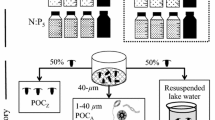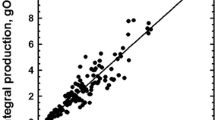Abstract
Under conditions of natural irradiance, the development and decline of a flagellate-dominated phytoplankton population was followed in a coastal North Atlantic pond over a 3 d period in summer 1986. Irradiance negatively affected phytoplankton biomass estimated as chlorophyll a, which decreased during the day at photosynthetically available radiation (PAR) levels above 600 to 1000 μmol m-2s-1; chlorophyll a increased at PAR values below this threshold. In addition, an inverse relationship was found between changes in chlorophyll a and changes in dissolved inorganic nitrogen, indicating synthesis of nitrogenous biomass mainly at night and degradation mainly during the day, with intense exchanges of material between the particulate and dissolved nitrogen fractions. The natural abundance of 13C in particulate matter increased initially, and then remained constant, and was controlled mainly by the ratio β-carboxylases activity: ribulose biphosphate carboxylase activity. The hypothesis that the latter enzyme is broken down under high irradiance and is partly responsible for increases in external dissolved nitrogen was rejected.
Similar content being viewed by others
Literature cited
Baker, K. S., Smith, R. C., Nelson, J. R. (1983). Chlorophyll determination with filter fluorometer: lamp/filter combination can minimize error. Limnol. Oceanogr. 28:1037–1040
Beardall, J., Morris, I. (1976). The concept of light intensity adaptation in marine phytoplankton: some experiments with Phaeodactylum tricornutum. Mar. Biol. 37: 377–387
Chesselet, R., Fontugne, M. R., Buat-Ménard, P., Ezat, U., Lambert, C. E. (1981). The origin of particulate organic carbon in the marine atmosphere as indicated by its stable carbon isotopic composition. Geophys. Res. Lett. 8: 345–348
Collos, Y., Linley, E. A. S., Frikha, M. G., Ravail, B. (1988a). Phytoplankton death and nitrification at low temperatures. Estuar. cstl Shelf Sci. 27: 341–347
Collos, Y., Maestrini, S. Y., Robert, J. M. (1989). Nocturnal synthesis and diurnal degradation of phytoplankton biomass in surface waters. Mar. Biol. 101: 457–462
Collos, Y., Manaud, F., Ravail, B., Cronin, A., Chaigneau, S. (1988b). Phytoplankton growth dynamics in temperate coastal marine ponds subjected to natural perturbations. In: Stadler, T., Mollion, J., Verdus, M. C., Karamanos, Y., Morvan, H., Christiansen, D. (eds.) Algal biotechnology. Elsevier Applied Science Publications, Amsterdam, p. 345–353
Cullen, J. J. (1988). Responses of phytoplankton to bright light characteristic of the sea surface. Eos Trans., Am. geophys. Un. 69: p. 1102
Descolas-Gros, C. (1985). La fixation du carbone inorganique par le phytoplancton marin: données bibliographiques sur les carboxylases et le rapport isotopique 13C/12C. Vie Milieu 35: 33–41
Descolas-Gros, C., Fontugne, M. R. (1985). Carbon fixation in marine phytoplankton: carboxylase activities and stable carbonisotope ratios; physiological and paleoclimatological aspects. Mar. Biol. 87: 1–6
Descolas-Gros, C., Fontugne, M. R. (1988). Carboxylase activities and carbon isotope ratios of Mediterranean phytoplankton. Oceanol. Acta (Nr. spéc.): 245–250
Descolas-Gros, C., Fontugne, M. R. (1990). Stable carbon isotope fractionation by marine phytoplankton during photosynthesis. Pl., Cell Envir. 13: 207–218
Döhler, G. (1985). Effect of UV-B radiation (290–320 nm) on the nitrogen metabolism of several marine diatoms. J. Pl. Physiol. 118: 391–400
Dortch, Q., Postel, J. R. (1989). Biochemical indicators of N utilization by phytoplankton during upwelling off the Washington coast. Limnol. Oceanogr. 34: 758–773
Ekman, P., Lignell, A., Pedersen, M. (1989). Localization of ribulose-1,5-biphosphate carboxylase/oxygenase in Gracilaria secundata (Rhodophyta) and its role as a nitrogen storage pool. Botanica mar. 32: 527–534
Ellis, R. J. (1979). The most abundant protein in the world. Trends biochem. Sciences 4: 241–244
Falkowski, P. G., Owens, T. G. (1980). Light-shade adaptation. Two strategies in marine phytoplankton. Pl. Physiol. 66: 592–595
Fontugne, M. R., Duplessy, J. C. (1978). Carbon isotope ratio of marine plankton related to surface water masses. Earth planet. Sci. Lett. 41: 365–371
Fontugne, M. R., Duplessy, J. C. (1981). Organic isotopic fractionation by marine plankton in the temperature range-1 to 31°C. Oceanol. Acta 4: 85–90
Hobbie, J. E., Daley, R. J., Jasper, S. (1977). Use of Nuclepore filters for counting bacteria by fluorescence microscopy. Appl. envirl Microbiol. 33: 1225–1228
Holm-Hansen, O., Lorenzen, C. J., Holmes, R. W., Strickland, J. D. H. (1965). Fluorometric determination of chlorophyll. J. Cons. perm. int. Explor. Mer 30: 3–15
Holm-Hansen, O., Riemann, B. (1978). Chlorophyll a determination: improvements in methodology. Oikos 30: 438–447
Huffaker, R. C., Peterson, L. W. (1974). Protein turnover in plants and possible means of its regulation. A. Rev. Pl. Physiol. 25: 363–392
Jitts, H. R., Morel, A., Saijo, Y. (1976). The relation of oceanic primary production to available photosynthetic irradiance. Aust. J. mar. Freshwat. Res. 27: 441–454
Maestrini, S. Y., Robert, J. M. (1981). Rendements d'utilisation des sels nutritifs et variations de l'état des cellules de trois diatomées de claires à huitres de Vendée. Oceanol. Acta 4: 13–21
Morel, A., Smith, R. C. (1974). Relation between total quanta and total energy for aquatic photosynthesis. Limnol. Oceanogr. 19: 591–600
Perry, M. J., Talbot, M. C., Alberte, R. S. (1981). Photoadaptation in marine phytoplankton: response of the photosynthetic unit. Mar. Biol. 62: 91–101
Prezelin, B. B. (1982). Effects of light intensity on aging of the dinoflagellate Gonyaulax polyedra. Mar. Biol. 69: 129–135
Rijn, J. van, Diab, S., Shilo, M. (1984). Mechanisms of ammonia transformations in fishponds. Spec. Publs eur. Maricult. Soc. 8: 17–40
Smith, J. C., Platt, T., Harrison, W. G. (1983). Photoadaptation of carboxylating enzymes and photosynthesis during a spring bloom. Prog. Oceanogr. 12: 425–459
Strickland, J. D. H. (1965). Production of organic matter in the primary stages of the marine food chain. In: Riley, J. P., Skirrow, G. (eds.) Chemical oceanography. Vol. I. Academic Press, London, p. 477–610
Utermöhl, H. (1958). Zur Vervollkommnung der quantitativen Phytoplankton-Methodik. Mitt. int. Verein. theor. angew. Limnol. 9: 1–38
Author information
Authors and Affiliations
Additional information
Communicated by J. M. Pérès, Marseille
Rights and permissions
About this article
Cite this article
Collos, Y., Descolas-Gros, C., Fontugne, M. et al. Carbon and nitrogen dynamics during growth and degradation of phytoplankton under natural surface irradiance. Marine Biology 112, 491–496 (1992). https://doi.org/10.1007/BF00356295
Accepted:
Published:
Issue Date:
DOI: https://doi.org/10.1007/BF00356295




